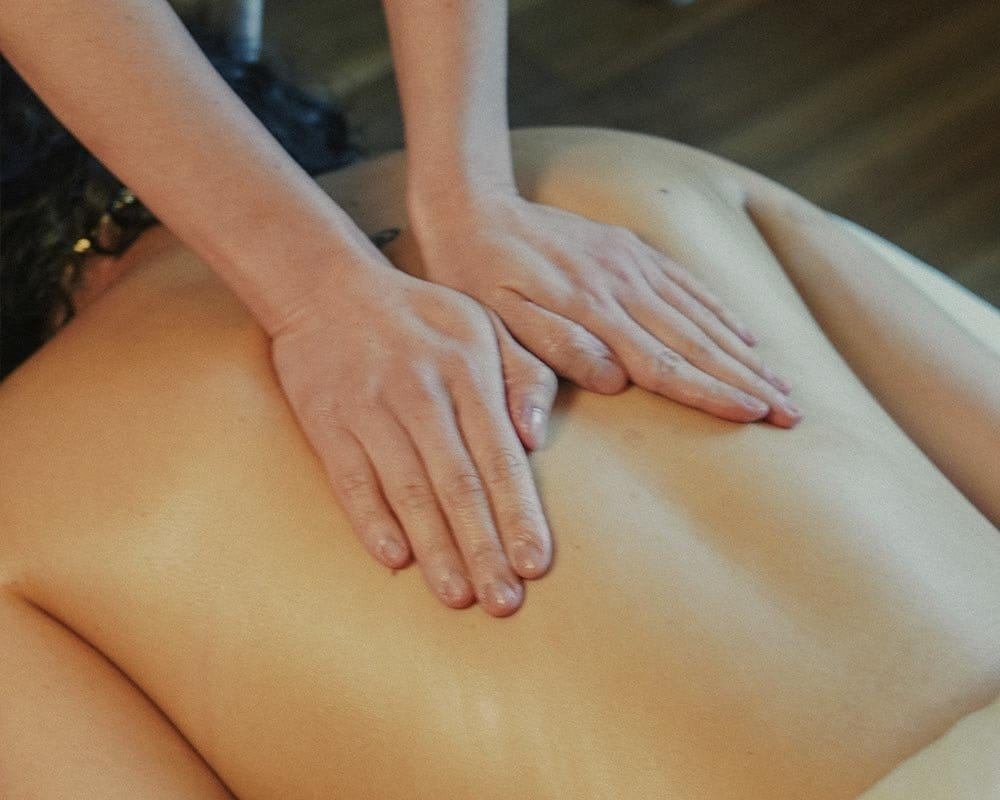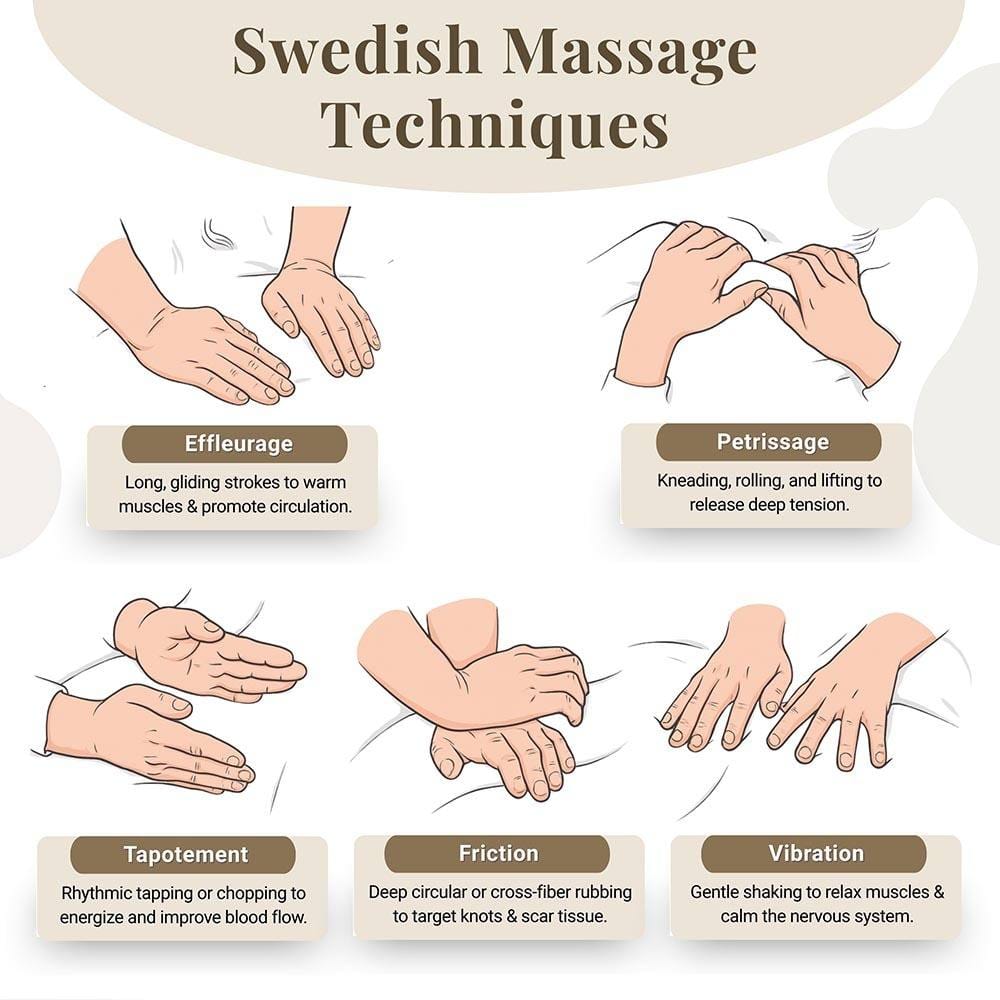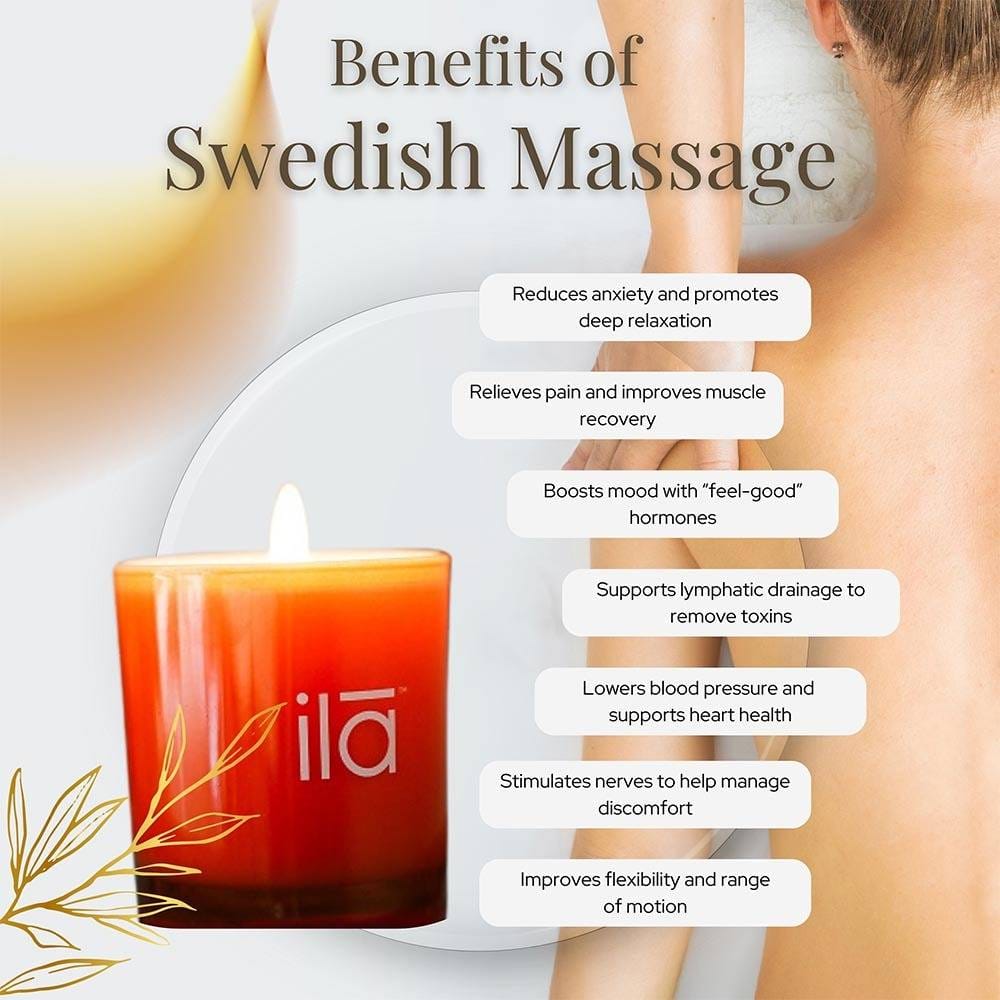Table of contents
People have practiced massage therapy for thousands of years, and it offers benefits beyond simple relaxation. It is a natural, effective way to re-energize the body and improve overall health. A massage therapist targets muscles using a combination of friction, gliding strokes, and kneading techniques. If you are looking for the best spa in New York City, one that blends expert technique with a calming, personalized touch, ila Only Spa is the place to go. Here, you can look forward to starting your journey to relaxation and wellness while enjoying a truly exceptional massage experience in serene and beautiful settings.
What Is a Swedish Massage?
 Swedish massage is a powerful tool for overall wellness. Whether you are dealing with pain, high levels of stress, or just need a break from your hectic life routine, a massage is a great way to unwind and relax your tight muscles.
Swedish massage is a powerful tool for overall wellness. Whether you are dealing with pain, high levels of stress, or just need a break from your hectic life routine, a massage is a great way to unwind and relax your tight muscles.
A Swedish massage offers numerous health benefits that range from easing muscle tension to boosting the immune system. A trained therapist manipulates the body’s soft tissues, including muscles, tendons, ligaments, and blood vessels, and use strokes that improve blood circulation. It can also help you manage conditions like the common cold, asthma, diabetes, and breast cancer.
Also known as classic massage, it is the most common form of massage therapy in Western countries, where you lie on a massage table and receive hands-on, tension-releasing treatment. It is considered the core technique that led to the creation of other types of massage therapy.
Techniques Used in Swedish Massage
Swedish massage is a whole-body treatment that has been designed to promote overall well-being. The main goal of this type of massage is to calm the body and mind and lightly release muscle tension. The therapist applies a combination of firm and light strokes to the muscles to relax the tissues and increase blood flow to the heart.
Swedish massage is a whole-body massage. It combines 5 basic elements and related techniques, each of them serving a specific purpose in easing tension and enhancing relaxation.

These elements include:
- Effleurage: It involves the use of long, gliding strokes with palms or fingertips to warm up the muscles and promote circulation. It is the initial stage that relaxes the body and prepares it for deeper techniques.
- Petrissage kneading: It involves kneading, rolling, squeezing, and lifting of the muscles, which releases tight areas and improves lymphatic drainage. This technique focuses on relieving deeper muscle tension and is performed with comfort in mind.
- Tapotement: This method focuses on rhythmic tapping, cupping, or chopping movements to stimulate nerves and muscles. Increased blood flow to the tissues and body enhances circulation and increases energy.
- Friction: The therapist uses their hands, forearms, and even elbows to rub and compress the body and warm the tissues. Deeper circular or cross-fiber rubbing motions target knots and adhesions to improve flexibility and break down scar tissue.
- Vibration: It relaxes muscles, relieves tension, and soothes the nervous system with gentle shaking and vibration of the body.
What to Expect?
If you are going for a Swedish massage for the first time, knowing what to expect can prepare you for the appointment and ensure maximum benefit.
Before the Massage
Before starting the massage, your therapist will ask some basic health and wellness questions. They will ask about your routine life, any health conditions or areas of concern, medications, and dietary information. They will also ask what you are looking for in a massage and if you have pain anywhere in the body.
You can also ask your therapist about their background, type of training and experience they have, and what their goals are when they give you a massage. Make sure to visit an accredited or licensed massage therapist for a safe and satisfying experience.
When You Arrive for the Massage
The therapist will ask you to undress and only leave comfortable clothing on. You will be asked to lie down on a massage table with a towel or sheet over your body. The therapist will partly remove this covering when they massage a particular part of the body, then place the covering back.
The therapist may also apply oils or lotions during the massage. If you have any allergies or sensitivity to certain elements, let your therapist know before they start the massage.
During the Massage
The therapist may dim the lights and play soft music or sounds in the background to create a relaxing environment during the massage session. If you prefer silence, ask them to turn the music or sounds off.
The massage therapist will use a blend of light and deeper pressure to move through each part of your body and employ movements like tapping, kneading, rolling, friction, and vibration to ensure desired results. Tell your massage therapist if the pressure is too deep or if it feels uncomfortable, if you want a different part of your body to be massaged, or want a change in pressure or technique.
A Swedish massage usually lasts between 30 and 90 minutes, but it can vary depending on your needs.
Benefits of a Swedish Massage
Health benefits of a Swedish massage include:
It Reduces Symptoms of Anxiety
Anxiety is a common mental health issue that causes persistent worry, restlessness, and muscle tension, all of which can affect mood and quality of life. Swedish massage is a natural and effective way to reduce these symptoms.
The long, soothing strokes and rhythmic techniques of Swedish massage calm the nervous system, lower stress hormones, and promote deep relaxation. This eases muscle tension and enables the mind to unwind, resulting in lessened anxiety.
It Lowers Blood Pressure
Swedish massage can also lessen the physical impact of anxiety, including high blood pressure, increased heart rate, and fast breathing. By encouraging deep relaxation and activating the parasympathetic nervous system, Swedish massage enables the body return to a calmer, more balanced state, which improves cardiovascular health and leads to better emotional well-being.
It Relieves Pain
Swedish massage can reduce pain by increasing blood flow to the muscles and flushing out metabolic waste that builds up from physical stress or tension. Improved circulation delivers more oxygen and nutrients to the tissues, which boosts healing and reduces soreness.
Whether you are experiencing chronic discomfort or general muscle fatigue, Swedish massage is an effective yet gentle way to manage pain and support recovery.
A Swedish massage can also help with the following:
Nerve Stimulation
By applying pressure and manipulating the muscles, Swedish massage can stimulate nerves located in different parts of the body. This stimulation of nerves in a certain way is used to manage pain and discomfort.
Mood Booster
Massage can improve mood by promoting the production of dopamine, serotonin, and oxytocin. These hormones work to stabilize your emotions and help you feel happy and positive. Swedish massage also reduces the production of cortisol, a stress-causing hormone, and elevate your mood.
Increased Flexibility
Massages can relax the joints and muscles. This not only enhances your range of motion but also results in your stretching capability, leading to improved flexibility.
Lymph Drainage
Lymphatic drainage occurs naturally when you use your muscles. If you do not use your muscles for any reason, it can lead to the accumulation of lymphatic fluid. This could cause a buildup of toxins. A Swedish massage can help manage this problem.
Tension Reliever
Knots, also known as adhesions, can be painful. A Swedish massage warms up the muscles and breaks down the binding spots, which relieves the tension gathered at the knots.
Reduces Symptoms of Depression
A Swedish massage can reduce symptoms of depression and stress, including back pain, headaches, muscle issues, and other chronic pains.
Swedish Massage vs. Deep Tissue Massage
Some people confuse Swedish massage with deep tissue massage, but there is a difference between the two. While deep tissue massage uses firm, deep pressure and the massage therapist focuses on a particular area of the body to work out knots and tension, Swedish massage uses long, fluid strokes and light-to-firm touch.
These techniques have different goals, too. Swedish massage focuses on relaxation, whereas deep tissue massage is more about releasing deep muscle tension and muscle pain.

Related article: What’s The Difference Between Swedish and Deep Tissue Massage?
Who Can Benefit From Swedish Massage Therapy?
Swedish massage is beneficial for people who seek short-term relief from pain and temporary relaxation.
It can help individuals suffering from:
- Muscle tension and mild pain
- Stress and anxiety
- Poor posture and muscle imbalance that result from sitting long hours at desks
- Sports injuries and workout stress
- Mild to moderate circulatory issues
Swedish massage is gentle and noninvasive, which is ideal for beginners to massage who are hesitant about deeper pressure techniques. It is also safe for older adults and helps with blood circulation, joint flexibility, and reduces feelings of loneliness. As it improves circulation and mobility, it increases comfort, reduces stiffness, and improves sleep.
Regular sessions can achieve long-term effects on pain and anxiety. Research has revealed that massage therapy is better than no treatment for chronic pain.
When Should You Avoid a Swedish Massage?
You should be cautious or stay away from Swedish massage if you have:
- Severe osteoporosis
- Blood clotting disorder
- Certain heart conditions
- Infectious skin diseases
- Undergone surgery or injury
Consult your doctor before getting a message if you have a medical condition or injury to prevent complications or worsening of your symptoms.
Risks Associated With Swedish Massage
Although this massage therapy is considered safe when performed by a professional and there are low risks of harm, there are occasional reports of complications from massage.
Potential side effects may include:
- Injuries
- Fractures
- Blood clots
These problems are more likely to affect people who are at high risk of injury, such as older adults or people with previous injuries.
Remember, Swedish massage is a complementary treatment for many conditions that offers countless psychological and physiological benefits. It not only helps people dealing with health conditions, but it is also highly recommended for fit and healthy individuals who want to maintain long-term well-being. Whether you are looking forward to relieving your aches and pain or simply seek a moment of deep relaxation, a Swedish massage is what you need.
Read more: Types of Massage
At ila Only Spa, we strive to provide a luxury massage experience you will not get anywhere else. Our licensed and highly trained massage therapists specialize in Swedish massage and other personalized treatments and create a perfect environment where your mind and body can unwind. They are always conscious of your comfort and safety, and ease away your body stress and tension to make you feel refreshed, balanced, and renewed with a satisfying session.
